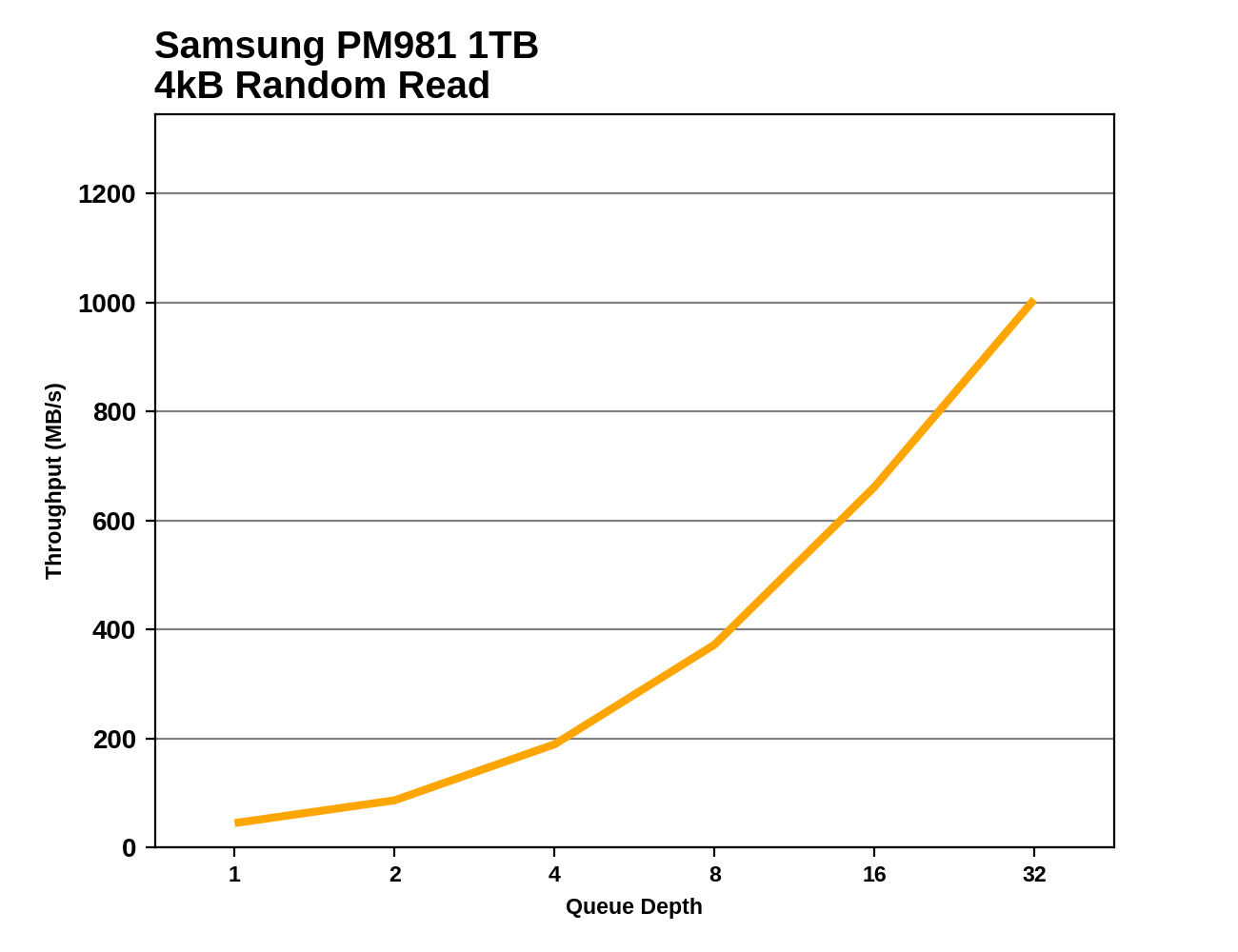The Samsung PM981 SSD Review (512GB, 1TB): Next Generation Controller And 3D NAND
by Billy Tallis on November 30, 2017 9:02 AM ESTRandom Read Performance
Our first test of random read performance uses very short bursts of operations issued one at a time with no queuing. The drives are given enough idle time between bursts to yield an overall duty cycle of 20%, so thermal throttling is impossible. Each burst consists of a total of 32MB of 4kB random reads, from a 16GB span of the disk. The total data read is 1GB.

The burst random read performance of the Samsung PM981 is great by the standards of TLC SSDs, but is surpassed by several MLC-based drives, including the Phison E7-based Patriot Hellfire with planar MLC NAND.
Our sustained random read performance is similar to the random read test from our 2015 test suite: queue depths from 1 to 32 are tested, and the average performance and power efficiency across QD1, QD2 and QD4 are reported as the primary scores. Each queue depth is tested for one minute or 32GB of data transferred, whichever is shorter. After each queue depth is tested, the drive is given up to one minute to cool off so that the higher queue depths are unlikely to be affected by accumulated heat build-up. The individual read operations are again 4kB, and cover a 64GB span of the drive.

On the longer random read test that includes some higher queue depths, the PM981 comes a bit closer to the standard set by Samsung's MLC drives, and it outperforms all the non-Samsung drives.
 |
|||||||||
Both capacities of the PM981 show performance scaling with queue depth in the typical manner for a high-performance drive, though the 512GB model has passed an inflection point by QD32 and is approaching saturation.
Random Write Performance
Our test of random write burst performance is structured similarly to the random read burst test, but each burst is only 4MB and the total test length is 128MB. The 4kB random write operations are distributed over a 16GB span of the drive, and the operations are issued one at a time with no queuing.

There are a few MLC-based SSDs that offer substantially higher burst random write performance than the Samsung PM981, but it is on par with most high-end drives including the Samsung 960 PRO.
As with the sustained random read test, our sustained 4kB random write test runs for up to one minute or 32GB per queue depth, covering a 64GB span of the drive and giving the drive up to 1 minute of idle time between queue depths to allow for write caches to be flushed and for the drive to cool down.

On the longer random write test, the 1TB PM981 stands out with clearly higher performance than the Samsung 960 series could manage. The 512GB PM981 is slower but still definitely performing like a high-end drive.
 |
|||||||||
The random write performance of the 1TB PM981 scales very well with increasing queue depth. As compared to the Samsung 960 series, it also reaches its plateau around QD8, but is providing much higher throughput by that point. The 512GB model runs out of SLC cache during portions of this test so its performance is much lower and less steady.










53 Comments
View All Comments
skavi - Monday, December 4, 2017 - link
Lol, tech isn't wine. If people aren't working to improve it, it won't get better.skavi - Monday, December 4, 2017 - link
Lol, tech isn't wine. If people aren't working to improve it, it won't get better.WorldWithoutMadness - Friday, December 1, 2017 - link
that and ram oligopoly. Almost reminded me of intel before ryzen.Drumsticks - Thursday, November 30, 2017 - link
I doubt we'll see 1TB 3D XPoint in an m.2 form factor until at least the second generation of XPoint. Power consumption looks too high; you'd probably have to severely limit performance to get into m.2, or you'd need a massive unrealistic heatsink.UltraWide - Thursday, November 30, 2017 - link
Yes, the people want to see 900p destroy these benchmarks!! :)romrunning - Thursday, November 30, 2017 - link
I would love to see the Optane 900p results included as well.peevee - Thursday, November 30, 2017 - link
Me too.mczak - Thursday, November 30, 2017 - link
I miss the power draw numbers.Drazick - Thursday, November 30, 2017 - link
I don't like those m.2 drives. Can't we have high bandwidth connection for 2.5 inch drives? It will have less thermal issues for desktop configurations.DanNeely - Thursday, November 30, 2017 - link
That's the barely gained any traction outside of enterprise U.2 connection.